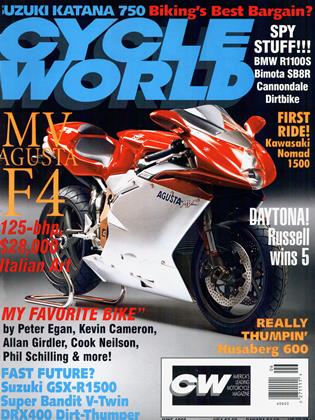A Pair of Sixes
Katana 600 vs. GSX-R600
SUZUKI HAS TWO 600CC SP0RTBIKES IN its 1998 lineup, the $6199 Katana 600 and $7799 GSX-R600. For the numerically challenged, that’s a $1600 difference. The obvious question, then, is what do you get for your money?
In the Katana’s case, you get a newly revamped version of a decade-old design. Back in 1988, when the Katana debuted, 600cc sportbikes were streetbikes
Suzuki
GSX-R600
first and racebikes second. Their steel frames and modest running gear were a step below that of cutting-edge 750s, which had to be built to handle the 130horsepower Superbike race engines of the day. Nonetheless, the Katana amassed an enviable track record, highlighted by Doug Polen’s AMA 600cc Supersport Championship.
Nowadays, the Katana is no match for the GSX-R600 and its ilk on the racetrack, but it remains fiercely competitive on the sales floor. Since 1990, it has been Suzuki’s low-priced leader, and has consistently ranked among the top-three best-selling sportbikes. True to form, this year’s sticker represents an increase of just $100 over last year, in spite of numerous upgrades.
As with the ’98 Katana 750, the 600’s 70-horsepower, air/oil-cooled, 16-valve, dohc inline-Four has received a raft of changes aimed at boosting low-end to midrange power. The valve-lash adjusters also have been changed from shim-type to screw-type, easing maintenance. And a redesigned crankcase moves the countershaft sprocket and chain run outboard to clear a wider rear tire.
Saddle up the small Kat, and you’ll find it an excellent around-town performer. The powerband is extremely linear, the steering light and neutral, the suspension supple, the new, twopiston, pin-slide front brakes strong and progressive. The 600 also scores high marks in freeway going, owing to good wind protection from the redesigned fairing (labeled “aerodynamic supersport,” presumably to avoid confusion with other, non-aerodynamic supersports) and a comfortable seating position, with bars just a fraction lower than the 750’s. Engine vibration can be intrusive, however, particularly in the region between 4500 and 6500 rpm-unfortunately, right in the heart of top-gear freeway cruising.
The Katana doesn’t disappoint on twisty backroads, either. Despite its limited range of adjustability (four clicks of rebound damping front and rear, plus a sevenposition shock spring-preload ramp), the suspension is amply damped. Only the old-style, damper-rod fork feels its age, as it bottoms under heavy braking (hard-chargers may want to raise the oil level). But then, the Katana isn’t really meant for this sort of repli-racy behavior.
The GSX-R600, on the other hand, is. Like its almost-identical bigger brother, the GSX-R750, the new-age supersport was designed to win races, with street usage a secondary consideration. Predictably, the Gixxer was lambasted in the press, losing out in street-based comparison tests due to its uncompromising ergonomics and peaky powerband.
Suzuki took steps to rectify the latter situation for 1998. Like the new Katanas, the GSX-R’s 92-horsepower, liquid-cooled inline-Four was retuned to boost midrange power, while not sacrificing anything on top. Acceleration was further improved by going up one tooth on the rear sprocket.
While those changes work as intended, they’re a bit pointless, really. As long as the GSX-R forces you to assume “the position,” it will never be a good, all-around streetbike-particularly when compared to the other, more user-friendly bikes that populate the 600cc class. What the GSX-R offers is peerless sporting prowess, allowed by such superior components as an aluminum twin-spar frame, fully adjustable cartridge fork and single shock, four-piston front brakes and wide wheels shod with premium Dunlop D207 radiais. To say the GSX-R handles well is an understatement; in fact, it is so responsive that sometimes the mere thought of turning causes the bike to veer in one direction or the other.
Suzuki
Katana 600
So, which Suzuki 600 is right for you? That depends on how you plan to use it. It’s tempting to say that if you’re a sporting sort of fellow, you should opt for the GSX-R. But in truth, it’s not that clear-cut. Unless you’re a highly skilled sporting fellow, you’d probably be quite happy aboard the Katana. Maybe even happier. Broad-based versatility or narrow-focused high-performance? The choice is yours.
Brian Catterson
 View Full Issue
View Full Issue












